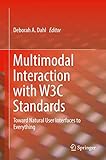Multimodal Interaction with W3C Standards [electronic resource] : Toward Natural User Interfaces to Everything / edited by Deborah A. Dahl.
Contributor(s): Dahl, Deborah A [editor.] | SpringerLink (Online service)
| SpringerLink (Online service) .
.
Material type:  BookPublisher: Cham : Springer International Publishing : Imprint: Springer, 2017Edition: 1st ed. 2017.Description: XXIX, 422 p. 555 illus., 430 illus. in color. online resource.Content type: text Media type: computer Carrier type: online resourceISBN: 9783319428161.Subject(s): Signal processing
BookPublisher: Cham : Springer International Publishing : Imprint: Springer, 2017Edition: 1st ed. 2017.Description: XXIX, 422 p. 555 illus., 430 illus. in color. online resource.Content type: text Media type: computer Carrier type: online resourceISBN: 9783319428161.Subject(s): Signal processingPart I Standards -- 1 Introduction to the Multimodal Architecture -- 2 The role and importance of speech standards -- 3 Extensible Multimodal Annotation for Intelligent Interactive Systems -- 4 Emotion Markup Language -- 5 Introduction to SCXML -- 6 Dialogue Acts -- 7 Six-Layered Model for Multi-Modal Interaction Systems -- 8 WebRTC handling media on the web -- Part II Implementations -- 9 Developing portable context-aware multimodal applications for connected devices using W3C multimodal architecture -- 10 SCXML on Resource Constrained Devices -- 11 A Standard Portal for Intelligent Services -- 12 Assembling the jigsaw How multiple W3C standards are synergistically combined in the HALEF multimodal dialog system -- Part III Applications -- 13 Applications in Ambient Assisted Living -- 14 Applications in Ambient Assisted Living -- Part IV Future Directions -- 15 Finding and integrating components into dynamic systems -- 16 Laborda Multimodal Interactivity in Foreign Language Testing -- 17 Multi-device applications using the multimodal architecture -- 18 Multimodal Interaction Description Language based on data modeling -- 19 Multimodal Fusion and Fission within the W3C MMI Architectural Pattern.
This book presents new standards for multimodal interaction published by the W3C and other standards bodies in straightforward and accessible language, while also illustrating the standards in operation through case studies and chapters on innovative implementations. The book illustrates how, as smart technology becomes ubiquitous, and appears in more and more different shapes and sizes, vendor-specific approaches to multimodal interaction become impractical, motivating the need for standards. This book covers standards for voice, emotion, natural language understanding, dialog, and multimodal architectures. The book describes the standards in a practical manner, making them accessible to developers, students, and researchers. Comprehensive resource that explains the W3C standards for multimodal interaction clear and straightforward way; Includes case studies of the use of the standards on a wide variety of devices, including mobile devices, tablets, wearables and robots, in applications such as assisted living, language learning, and health care; Features illustrative examples of implementations that use the standards, to help spark innovative ideas for future applications.


There are no comments for this item.